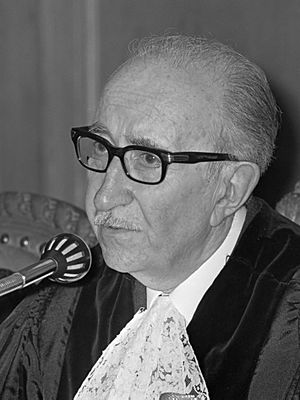José Luis Bustamante y Rivero facts for kids
Quick facts for kids
José Luis Bustamante y Rivero
|
|
|---|---|

José Luis Bustamante y Rivero (1968)
|
|
| 44th President of Peru | |
| In office July 28, 1945 – October 29, 1948 |
|
| Vice President | José Gálvez Barrenechea Eduardo Ganoza y Ganoza |
| Preceded by | Manuel Prado y Ugarteche |
| Succeeded by | Manuel Odría |
| Senator for Life Former President of the Republic |
|
| In office 26 July 1980 – 11 January 1989 |
|
| President of the International Court of Justice | |
| In office 5 February 1967 – 5 February 1970 |
|
| Preceded by | Percy Spender |
| Succeeded by | Muhammad Zafarullah Khan |
| Minister of Justice, Instruction and Worship | |
| In office 24 November 1930 – 31 January 1931 |
|
| President | Luis Miguel Sánchez Cerro |
| Preceded by | Armando Sologuren |
| Succeeded by | Elías Lozada Benavente |
| Personal details | |
| Born | 15 January 1894 Arequipa, Peru |
| Died | 11 January 1989 (aged 94) Lima, Peru |
| Political party | Frente Democrático Nacional |
| Spouse | María Jesús Rivera |
| Children | 2 |
José Luis Bustamante y Rivero (born January 15, 1894 – died January 11, 1989) was an important Peruvian leader. He was a lawyer, writer, and diplomat. He became the 44th President of Peru from 1945 to 1948. Later, he even led the International Court of Justice in The Hague.
Contents
Early Life and Education
José Luis Bustamante y Rivero was born in Arequipa, Peru, in 1894. His parents were Manuel Bustamante y Barreda and Victoria de Rivero y Romero. José married María Jesús Rivera in 1923. He went to Colegio San José for his early education. He then studied law at the Universidad Nacional San Agustín de Arequipa. He also earned a Ph.D. from the Universidad Nacional San Antonio Abad in Cusco. After working as a professor and legal expert, he decided to get involved in politics.
Start in Politics and Diplomacy
Bustamante became known in politics after writing a special statement. This statement helped remove President Augusto B. Leguía from power in 1930. He then gained the trust of the new leader, Luis Miguel Sánchez Cerro.
In 1934, Bustamante started a new career as a diplomat. He represented Peru in other countries. He served as the Peruvian Minister (like an ambassador) to Bolivia from 1934 to 1938 and again from 1942 to 1945. He was also the Minister to Uruguay from 1939 to 1942.
Running for President
In 1945, José Luis Bustamante y Rivero ran for President of Peru. He was part of the Frente Democrático Nacional party. This party was a moderate group that worked with other parties. His opponent was General Eloy G. Ureta. Bustamante won the election easily. Many people saw this election as one of the fairest Peru had in many years.
Presidency of Peru
When Bustamante became President, he quickly made important changes. He brought back freedom of the press. He also restored full civil rights for citizens. All political prisoners were set free. He worked to limit the power of the military and wealthy families.
One major achievement was extending Peru's control over the sea. He declared that Peru's sovereignty reached 200 miles out from its coast. This idea became widely accepted in international law.
However, his presidency faced challenges. There were disagreements with some political parties. Economic problems and strong labor unions also caused difficulties. In October 1948, some rebel sailors and officers tried to take control. Government troops stopped the revolt. President Bustamante then suspended civil rights. He said the revolt was caused by a specific political party.
Despite his efforts, a military coup happened on October 29, 1948. General Manuel A. Odría took over as the new President. Bustamante went into exile the same day. He moved to Argentina.
After the Presidency
While in exile, Bustamante lived in Buenos Aires, Madrid, and Paris. In 1956, he returned to Peru, which surprised many people.
In 1960, he was chosen to be a judge at the International Court of Justice in The Hague. This court helps solve legal problems between countries. He served as its President from 1967 to 1970.
In 1969, the Organization of American States asked Bustamante to help solve a border conflict. This conflict was between El Salvador and Honduras. It was known as the Football War. Thanks to his efforts, a peace treaty was signed in 1980.
As a former president, Bustamante later became a senator for life in Peru. This was allowed by the Peruvian Constitution of 1979. He served as a senator from 1980 until his death.
José Luis Bustamante y Rivero passed away in Lima in 1989. He was 94 years old.
Published Works
José Bustamante wrote several books about law and other topics. His works are kept in the National Library of Peru. Some of his published works include:
- Arequipa (1947)
- Tres años de lucha por la democracia en el Perú (Three Years of Struggle for Democracy in Peru) (1949)
- Panamericanismo e iberoamericanismo (Pan-Americanism and Ibero-Americanism) (1951)
- Artesanía textil en el Perú (Textile Crafts in Peru) (1952)
- Mensaje al Perú: Perú, estructura social (Message to Peru: Peru, Social Structure) (1960)
- La Corte Internacional de justicia (The International Court of Justice) (1964)
- Una visión del Perú (A Vision of Peru) (1972)
- Derecho del mar (Law of the Sea) (1972)
Images for kids
See also
 In Spanish: José Luis Bustamante y Rivero para niños
In Spanish: José Luis Bustamante y Rivero para niños


